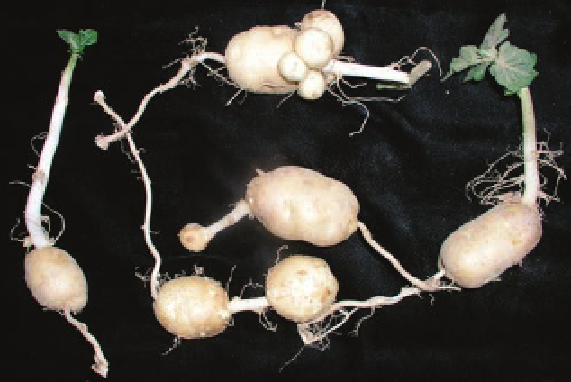Agriculture Reference
In-Depth Information
14.6
Second Growth
cases, a stolon develops from primary tuber eyes
and a secondary tuber forms at the end of the
stolon (Lugt, 1960; Lugt
et al
., 1964; Okazawa
and Iriuda, 1980). Small, young tubers have a
greater tendency to produce stolons at the bud
end (Krauss, 1985). In severe cases, secondary
tubers form directly from the primary tuber eye.
Heat sprouts and chain tubers result when
tuber growth is renewed after development has
been interrupted during extended exposure to
warm soil temperatures or excessive nitrogen. Se-
cond growth is related to reduced apical domin-
ance of primary tubers, a temporary alteration
in tuberization response, or disruption of source-
sink relationships (Bodlaender
et al
., 1964; Lugt
et al
., 1964; Krauss, 1985). Gibberellin (GA), the
phytohormone believed to be the dominant regu-
lator of tuber formation, is high in elongating
stolon tips and low in developing tubers (Xu
et al
.,
1998). Low GA levels promote tuber growth and
high GA activity inhibits tuber growth. Xu
et al
.
(1998) demonstrated that by alternating be-
tween low and high GA-containing media, chain
tubers could be induced to form on cuttings
in vitro
. With high soil temperature or high nitro-
gen endogenous GA levels increase, tuber growth
ceases and regrowth (i.e. new stolon growth) occurs
(Krauss, 1985). When temperature decreases or
nitrogen is removed, the plants revert back to a
tuberizing state.
When chain tubers occur, the secondary
tuber becomes dominant and the primary tuber
There are three distinct types of second growth
expressed by potato plants in the field: heat
sprouts, also known as aerial sprouts or heat
runners; chain tubers, also called tuber chain-
ing, gemmation, or chain tuberization; and little
tuber, also called kinder tuber, little potato,
sprout tuber, or no top.
are caused by high soil temperatures (28°C and
higher), with or without drought (Bodlaender
et al
., 1964). Water stress alone does not cause
these types of second growth. The longer the
period of elevated temperature and the higher
the temperature, the more second-growth
tubers will be found (Bodlaender
et al
., 1964;
Lugt
et al
., 1964). Fluctuating nitrogen nutri-
tion is also known to result in second growth
(Krauss, 1985).
Heat sprouts arise from stolon or tuber
buds. They grow as short sprouts underground
that elongate, emerge from the soil, and develop
into leafy aboveground stems. Heat sprouts may
develop before tubers are set, or from stolon ref-
ormation from the bud end of tubers at any
stage of tuber development. Heat sprouts often
develop when tubers are close to the soil surface.
Chain tuber refers to multiple, small tubers
forming on a single stolon. High temperatures
favor stolon branching (Struik
et al
., 1989), and
a tuber forms on each branch or bud. In some
Fig. 14.2.
Heat sprouts and chain tubers, two types of second growth. (Photo courtesy or L. van Marion,
McCain Foods Europe.)

